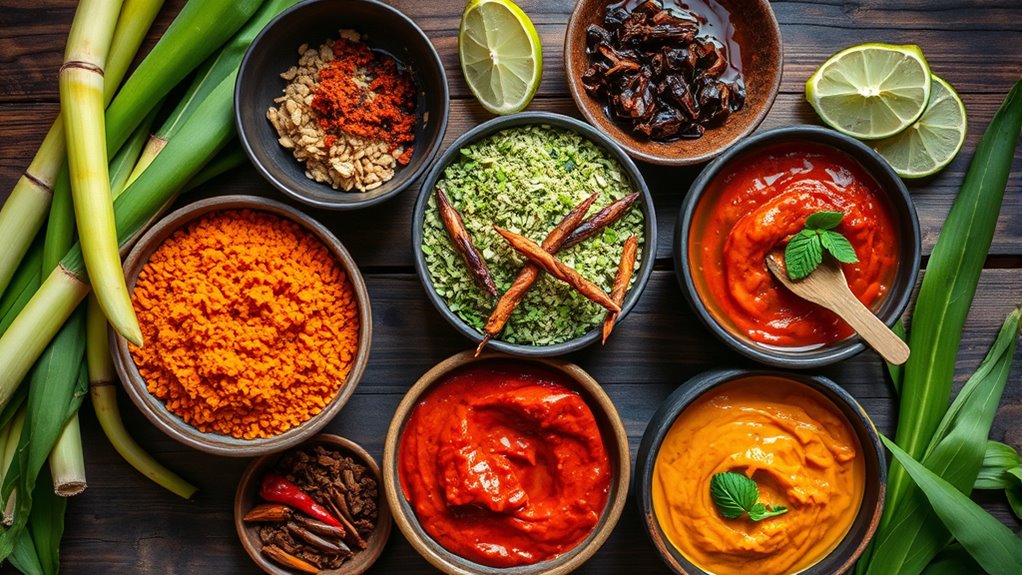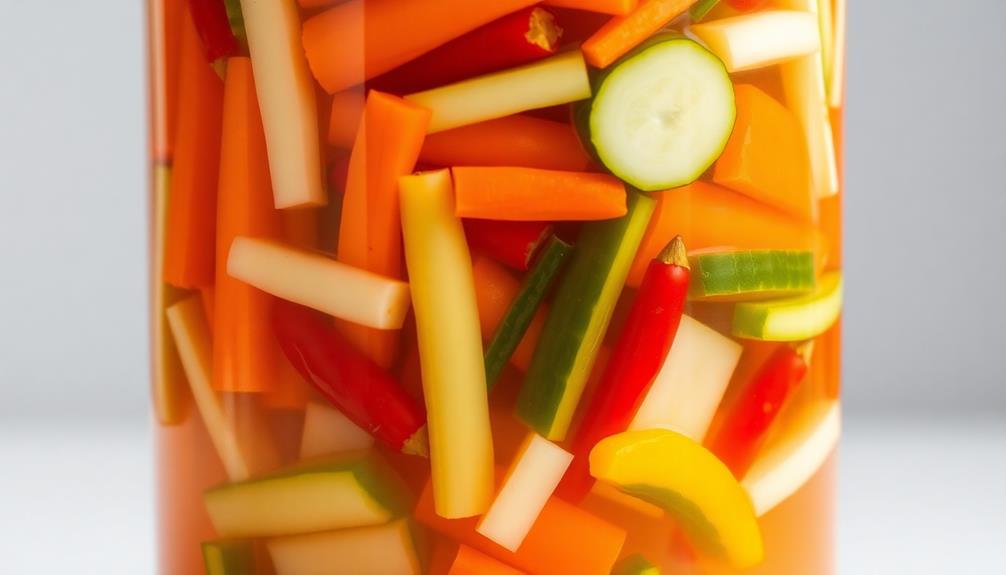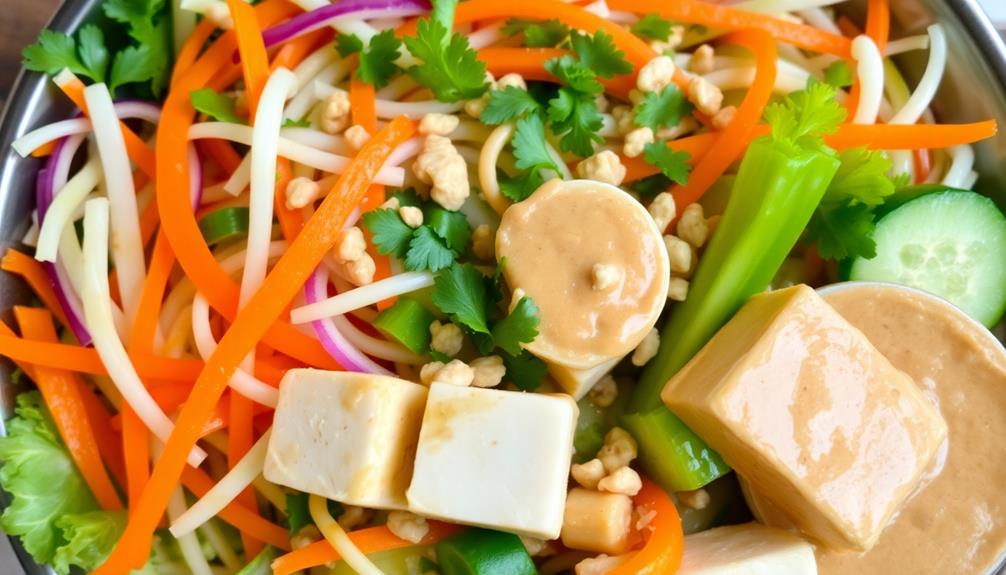Balinese bumbu base pastes are the flavorful foundation that brings authenticity and vibrancy to traditional dishes. You’ll find these pastes crafted from fragrant spices like turmeric, ginger, galangal, garlic, and chili, prepared through roasting, pounding, and blending. This careful process releases potent aromas and deepens flavors, capturing Bali’s culinary spirit. Exploring these techniques reveals how the aromatics behind the magic truly define Balinese cuisine—continue exploring to uncover more of these flavorful secrets.
Key Takeaways
- Bumbu base pastes are foundational in Balinese cuisine, providing depth, aroma, and authentic flavors to traditional dishes.
- Key ingredients like turmeric, galangal, garlic, and chili peppers are carefully blended to create complex aromatics.
- Preparation involves roasting and pounding spices using traditional tools to maximize flavor and preserve cultural authenticity.
- Crafting these pastes reflects Balinese culinary artistry, emphasizing harmony, patience, and respect for tradition.
- Properly prepared bumbu pastes enhance the vibrancy and fragrance of dishes, embodying Bali’s rich culinary heritage.

Balinese cuisine is renowned for its rich flavors and vibrant aromas, and at the heart of these dishes are bumbu base pastes. These pastes serve as the foundation for many traditional dishes, infusing them with complex layers of taste and fragrance. When you start exploring Balinese cooking, you’ll quickly realize that mastering the art of creating these pastes is essential. The process involves meticulous spice blending and traditional preparation methods that have been passed down through generations, preserving the authenticity of each flavor profile.
Spice blending is at the core of making true Balinese bumbu base pastes. You carefully select a variety of ingredients like turmeric, ginger, galangal, garlic, shallots, and chili peppers, each contributing its unique aroma and depth. The key is to balance these components so that no single spice overpowers the others, resulting in a harmonious mixture. You might also add lemongrass, kaffir lime leaves, or candlenuts to enhance complexity. This precise spice blending requires attention to detail and an understanding of how different ingredients interact, which is why traditional preparation methods are so vital. They guarantee that each element is prepared in a way that maximizes flavor extraction—whether that means roasting spices to deepen aroma or pounding them into a paste for better integration.
In traditional preparation, you often start by roasting or frying the spices lightly to release essential oils and intensify their fragrance. This step is pivotal because it transforms raw ingredients into a fragrant, cohesive paste. You then grind or pound the roasted spices with mortar and pestle, which allows for better control over texture and flavor release. The traditional approach emphasizes patience and attention, as rushing the process can diminish the richness of the final paste. Once the spices are thoroughly combined, you can use the paste immediately or store it in an airtight container for later use. This method preserves the freshness and potency of the aromatics, making your dishes more vibrant and authentic. Additionally, understanding the authentic preparation methods is crucial for achieving the true essence of Balinese flavors.
Creating Balinese bumbu base pastes is more than just mixing ingredients; it’s an art rooted in tradition. Every step—from selecting the freshest spices to the slow, deliberate pounding—reflects a cultural heritage that values harmony and balance in flavor. By understanding and practicing traditional preparation, you guarantee that every dish you prepare carries the genuine essence of Balinese cuisine. It’s this careful spice blending and respect for tradition that results in dishes bursting with vibrant aromas, enticing your senses and transporting you straight to the heart of Bali.
Frequently Asked Questions
How Long Do Balinese Bumbu Base Pastes Last?
You can usually keep Balinese bumbu base pastes in the fridge for about 1 to 2 weeks. To extend their flavor preservation, store them in an airtight container and make certain they’re well-sealed. The fermentation process helps develop their rich aroma, but it also means they can spoil if left too long. For longer storage, consider freezing the pastes, which maintains their flavor and freshness for up to 3 months.
Can I Substitute Ingredients in Traditional Recipes?
You can definitely experiment with ingredient flexibility in traditional recipes, but keep in mind it may impact the flavor. If you substitute ingredients, taste as you go to make flavor adjustments. For example, swapping a less spicy chili or a milder garlic can alter the overall profile. Stay attentive to balance, and you’ll create a delicious dish while respecting the essence of the original recipe.
Are There Regional Variations of Balinese Bumbu Pastes?
Like a river flowing through diverse lands, Balinese bumbu pastes reflect regional flavor profiles that vary across Bali. You’ll find differences in ingredient substitutions, influenced by local ingredients and traditions. These regional variations give each paste its own character, turning a simple recipe into a vibrant tapestry of flavors. Embracing these differences allows you to explore the rich culinary diversity of Bali and make each dish uniquely yours.
What Are Common Dishes Using These Pastes?
You’ll find these bumbu pastes in many Balinese dishes, both traditional and modern. They’re essential for making vegetarian options like sayur urap or tahu goreng, as well as seafood dishes such as ikan bakar or udang sambal. The pastes add depth and flavor, transforming simple ingredients into vibrant, aromatic meals. Experimenting with these pastes helps you create authentic Balinese flavors, whether you prefer plant-based or seafood dishes.
How Do I Store Bumbu Pastes to Maintain Freshness?
To keep your bumbu pastes fresh, you should focus on proper storage. Store them in airtight containers and keep them in the refrigerator for short-term use. For longer preservation, freezing techniques work best—you can freeze in small portions using ice cube trays, then transfer the cubes to a sealed bag. This way, you maintain the vibrant flavors and aroma, ensuring your pastes stay fresh for future cooking adventures.
Conclusion
Now that you understand the richness and complexity behind Balinese bumbu base pastes, you can appreciate the magic they add to every dish. You see how aromatics transform simple ingredients into flavorful masterpieces, how tradition and technique blend into every spoonful. With this knowledge, you can experiment, create, and share the vibrant tastes of Bali. Embrace the aroma, embrace the tradition, and let your kitchen become a gateway to Bali’s culinary soul.









